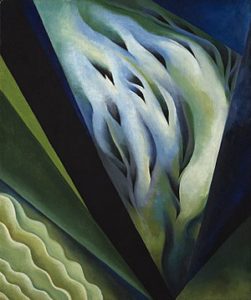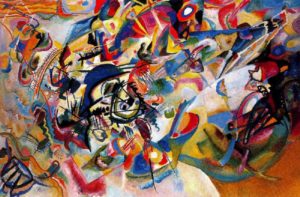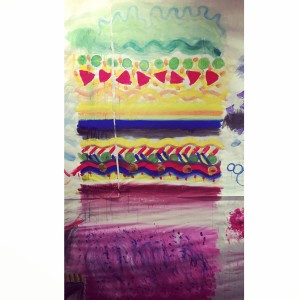Programmatic Music is a type of music that correlates with a story or a visual. By listening to pieces such as Berlioz’s Symphonie Fantastique, or Aaron Copland’s Rodeo and have students create a visual based off of what they hear. This can be a simple drawing, or can be used with other mediums. This lesson would be used with the study of Programmatic Music, after talking about certain keys, colors, rhythms and meters and how they convey different pictures or visuals in our heads. Student may also write a story for extra credit.
A programmatic piece of music that could be incorporated into the curriculum, for the high school/advanced middle school is the piece Blue and Green Music. The original painting titled Blue and Green Music by Georgia O’Keefe showcases different tones, meter and rhythms. The piece of music that was created shortly after by Samuel R. Hazo, follows the paintings expression and meaning and gives a stunning emotional performance.
Blue and Green Music, by Georgia O’Keefe
Piece of Music: Blue and Green Music, by Samuel R. Hazo:
Another example of visual and musical art correlating is the movie Fantasia. This is a great segue for students to understand the visual aspect of music, and how it has the potential to connect in various ways. Both Fantasia and Fantasia 2000 demonstrate Disney artists ideas or stories based off classical works of music. Again, giving a potential idea of what the student’s imagination can create. This might follow with, what do you see? What kind of story did you hear?
Wassily Kandinsky, was one of the most musically influenced artists of the 20th century. One of his biggest works, was a series of “compositions”, influenced by music. Kandinsky once said “music is the ultimate teacher”. He explored shapes, colors, textures and rhythmic patterns throughly. His work could easily start a classroom conversation about the relationship between art and music patterns and the visual translation.
Kandinsky’s Composition VII
We listened to six different musical examples and discussed these elements. While listening to the example the second time, we were instructed to paint these concepts in a class mural type environment.
I worked from top to bottom, where others decided to work from bottom to top, or random. This is my interoperation of the following six music examples:
1) Erik Satie – Gymnopédie No.1
2) Gold Brass Quintet – Fuchsgraben Polka
3) Chopin Ballade No. 3 (Cynthia Tobey)
4) King Sunny Ade – Ja Funmi (Waka Version)
5) Pablo Casals plays Bach Suite #1
6) Flower Duet – Anna Netrebko & Elina Garanca (Lakmé de Delibes)
Here are some key concepts to include when having a discussion with students: rhythm, dynamics, melody, harmony, tone color, texture, form and style.
Students Will Be Able To: Musically respond to the different compositional elements that make up a visual piece of art. Students will be assigned a piece of art and instructed to correlate a song with the image. Elements include: dynamics, form, rhythm, tone color, tempo, melody, and harmony.
Visual Art & Music Tech Rubric
Project Tutorial:
Teacher Example:
SoundCloud Playlist
The Case for Abstraction-PBS
Art With Mati & Dada
YouTube Visual Art Playlist


